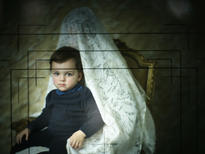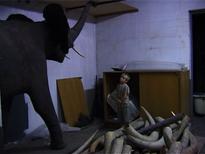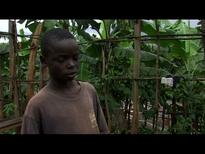SARAH VANAGT
Could the fantasy world of a child provide a secret passage into the past? This question is the starting-point of Sarah Vanagt’s research on the “historical imagination” of children. How do children deal with the past, or rather, how do they shape it in their imagination? This issue was initiated in the video Little Figures (2003), in which Vanagt, who studied history at the universities of Antwerp, Sussex and Groningen, and film at the National Film and Television School (UK), had children of immigrants carry out an imaginary conversation between three historical figures, immortalized as statues in Brussels. This resulted in a blend of personal experiences, imagined story twists and connections, as well as shreds of previously overheard information. Precisely this twilight zone between knowing and not-knowing is fascinating – when children fill the gaps in their knowledge and understanding with building bricks from their own fantasy world.
The same curiosity instigated the documentary Begin Began Begun (2005), which situates itself in the borderline between Rwanda and the Democratic Republic of Congo. A violent conflict has been going on there for over 10 years. Sarah Vanagt went on the lookout for the miniature worlds children set up while they are playing – worlds in which time is stretched out and cut short on their own discretion, where objects are brought to life, where the boundaries between reality and imagination, life and death, order and chaos fade away. The children seem to be playing with pieces from the past, as it were.
The installation Les Mouchoirs de Kabila (2005) begins where Begin Began Begun ends: with images of refugee children in Goma, playing amongst the lava fragments which disrupted the city. From found material they build up a miniature city. Old, used phone cards suddenly turn into TV-screens, in a sardine tin which was converted into a living room; a piece of metal is bent to become a wheelchair. Cities rise and fall at each shower of rain. Everything is lava, lava is everything: arms, building bricks, diamonds. The ground underneath their petrified feet, the air for their asthmatic lungs. The cause for their illness, a source of income. In order to make money the children sort the pieces of lava, which is subsequently processed as cement, or they sell paper handkerchiefs.
While Begin Began Begun is mostly situated at the Rwandese side of the border, the image material for the installation was filmed for the most part at the Congolese side of the border. Whereas the game of the Rwandese children was part of the tenth anniversary of the genocide, the game of the children in Goma mainly reflects the current chaos, the corruption and the election fever in Eastern Congo. Their game becomes a barometer for the political climate in the area. Death takes up a central position: dolls are buried between lava fragments, the dead fall and rise again. The children seem to turn into wandering links between the living and the dead, as larvae creeping from underneath the vast, dark lava surface in order to report from another world, the world underneath the ruins. As if they were playing knucklebones with the spines of millions of dead people in packed graves.
The work of Sarah Vanagt offers glimpses of that “in-between space”, as an image of a society in which the surreal and the imaginary keep merging more and more, where the invisible might even have pushed aside the visible. The tiny world of fairytale is used as a prism to watch at the ‘greater world’. The trajectory the dolls cover in their cars – which is also the trip the spectator makes through the imaginary world of the children – is nothing more than a detour to get to reality.





- ° 1976 Bruges (Belgium). Lives and works in Brussels.
-
Links
-
EVENTS
- Limes - Voyages de frontière
- Into the World, Out on the Street
- RENDEZ VOUS DES DOCS
- Politically today _part1
- So Happy. A Selection of Joyful Rebellions from the Argos Distribution Catalogue [12th Rencontres Internationales, Círculo de Bellas Artes, Madrid]
- Histories of a Picture to Come
- Silver Bliss #2: Portrait of A City
- FID Marseille 2015
- Unconventional gazes - An argos carte blache for Vidéographies [21] Festival
- With /in/out the margins
- Erfgoeddag 2011: The canal neighbourhood: my world? The past and prospects of a Brussels neighbourhood
- New Stories for Brussels. Strategies for a Dissident Reading of the City. On the image of the Belgian capital in recent video art.
- Sarah Vanagt Focus [UNDERDOX - dokument und experiment]
- International Short Film Festival Oberhausen 2012: Market Screening
- Video Library
- Hors Pistes Sao Paulo 2013
- Sarah Vanagt & Katrien Vermeire - The Wave
- World Day for Audiovisual Heritage 2016
- Ciclo Vídeo Belga
- EMAF 2016
- Sven Sterken: New Stories for Brussels. Strategies for a dissident Imagination of the City
- Argos Media Library
- Videoex 2011: Guestcity Brussels
- New Myths for Brussels
- ART BRUSSELS 2014. Selection from the collection of Argos
- Passages. La photographie dans l’art vidéo contemporain
- Sarah Vanagt - Les mouchoirs de Kabila
- C12 x ARGOS = 30
- Sarah Vanagt - Little Figures
- IFFR - International Film Festival Rotterdam 2012
- Zona de mestizaje - Cine y Vídeo de Artistas Belgas
- Money! A screening for Black Market
- IFFR - International Film Festival Rotterdam 2014
- Look at Me
- Argos @ Macro Asilo
- COM nu TIES seuils/drempels/thresholds - A duoshow with ISELP
- The Wave & Los Caminos de la Memoria
- Demonstrationen. Vom Werden normativer Ordnungen
- Screenings and Rencontres
- European Media Art Festival 2010
- Sarah Vanagt - Boulevard d'Ypres / Ieperlaan
-
At view in the media library
NEW ACQUISITIONS
OTHER WORKS- After Years of Walking
- Alle de tranen / Every Tear / Toute larme
- Ash Tree
- Baby Elephant
- Begin Began Begun
- Boulevard d'Ypres / Ieperlaan
- Divinations
- Elevage de poussière / Dust breeding
- First elections [v.2 - 2007]
- Girl with a Fly
- In Waking Hours
- Les mouchoirs de Kabila
- Little Figures
- Money Exchange
- Power Cut
- Silent Elections
- Still holding still
- The Corridor
- The Wave